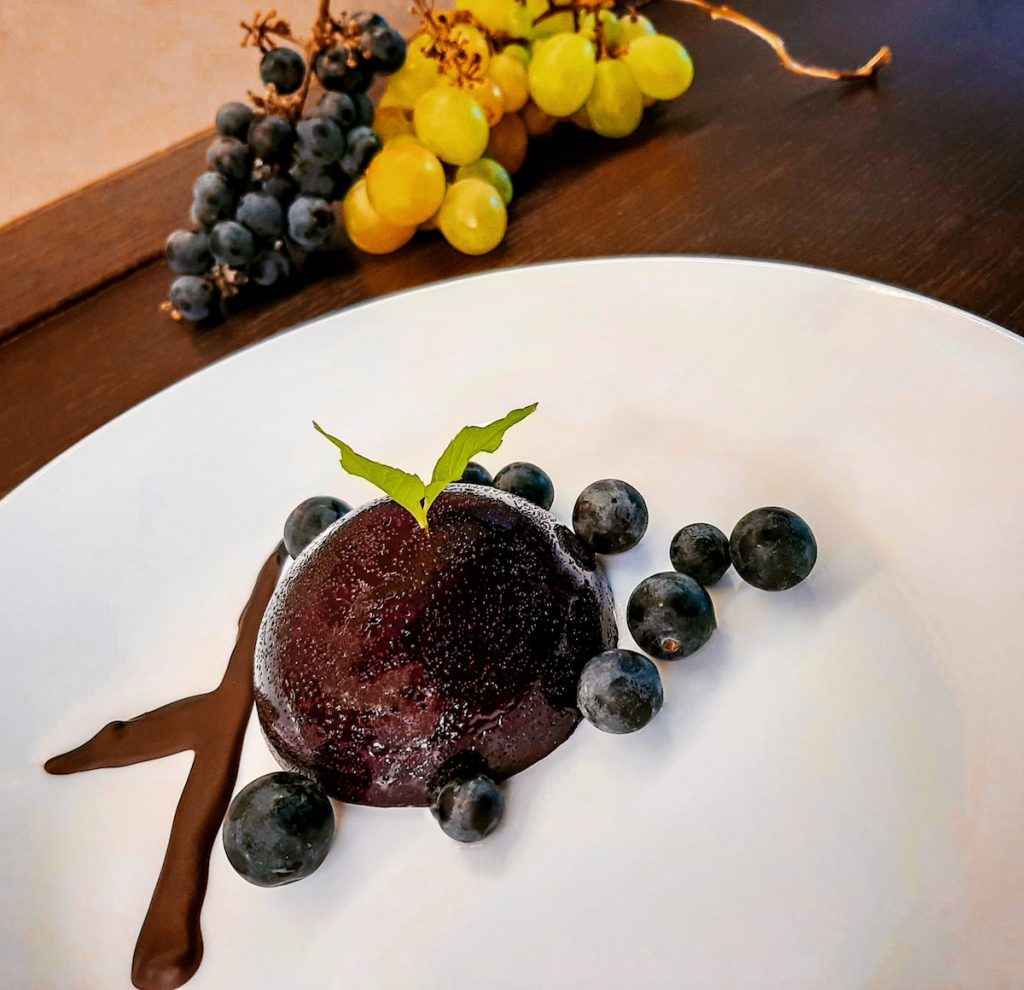How to Make Sugolo di Uva Fragola or Strawberry Grape Pudding

When speaking about Italian food, one can say that “nothing goes to waste.” You may find some obscure dishes pulled from La Cucina Italiana archives, which would make great content for a future article… However, today’s Sugolo di Uva Fragola recipe celebrates harvest and it’s simply delicious! This poor man’s dessert is made from grape must – fresh, pressed grape juice that usually contains skins, seeds and stems. We say “poor,” because it has peasant roots and was originally made from grapes not usable for wine.
For our Italian readers, we hope it brings back fond memories rather than images of imperfect fruit that you’d think was only fit for the trash.
For our English-speaking readers, practice your Italian by reading it before jumping to the bottom where we’ve added the recipe in English.
Grazie Lorenzo for sharing this recipe, history and photo with Live in Italy Magazine!
Il Sugolo
Le sue origini sono antichissime e sono legate alla storia contadina italiana, una prelibatezza tipica della stagione della vendemmia, difatti erano soprattutto le famiglie che possedevano vigneti a fare questo strepitoso budino con il mosto. Un dolce povero, che nasce dall ingegno dei tempi dove non si buttava via niente, i sugoli infatti venivano fatti con gli acini più rovinati, non adatti per il vino che non venivano così sprecati. Per la preparezione si possono utilizzare anche con le uve bianche ma per la corretta riuscita del piatto occorrerebbe dell’uva fragola detta anche, in alcune zone, uva americana, comunque si utilizzano uve da vino, come vuole la tradizione. La ricetta originale prevede la sgranatura dei grappoli e la lessatura degli acini detta anche “la crepàda” proprio perche gli acini non vanno pigiati ma fatti “crepare” in pentola. Un tempo il succo prodotto con la “crepàda” veniva unito alla farina bianca e messo a cuocere in un paiolo di rame insieme a una enorme chiave di ferro in grado di neutralizzare i rischi tossici dell’ossidazione dell’interno della pentola.
Il Procedimento
- Lavare molto bene i grappoli, sistemarli in una pentola e portare a cottura, a fiamma normale, sino a che gli acini non si rompono. Questa operazione consente di estrarre le sostanze tanniche che si trovano nella buccia e che daranno il gusto e la colorazione tipica al piatto.
- Spremere bene gli acini con le mani, aiutandosi magari con un colapasta o un setaccio, stando bene attenti che nessun seme entri nel liquido.
- Misurare il liquido ottenuto.
- Unire poi, stemperando bene con una frusta, 120 grammi di farina bianca doppio zero( o maizena) per litro di mosto. Niente zucchero perché è già sufficiente quello dell’uva stessa se vendemmiata matura, talvolta, però, l’ uva risulta essere troppo asprigna e quindi se ne aggiunge un pochino. Esiste anche un trucco per ovviare a questo problema, ovvero mettere in cottura un pezzettino di pane ben raffermo, senza romperlo in modo da riuscire a toglierlo in seguito. Questo dovrebbe proprio avere la funzione di assorbire l’acido in eccesso.
- Porre sul fuoco mescolando continuamente. Portare ad ebollizzione. Il sugolo va consumato freddo e si può conservare in frigorifero anche per un mese. In questo caso, prima di servirlo, basta togliere la muffa che si sarà certamente formata in superficie chè non è segno di deterioramento del sugolo, ma indice di genuinità secondo i veri intenditori, proprio come per alcuni formaggi. Una prelibatezza di questo periodo assolutanente da provare, che dire…buon appetito!
The Sugolo
Its origins are very ancient and are linked to Italian peasant history. It is a typical delicacy of the harvest season. In fact, it is cherished by all families who owned vineyards and who made this amazing pudding with the must. Originally, it was a poor man’s dessert, and was born from the ingenuity of the times when nothing was thrown away. Specifically, sugoli (plural for sugolo) were made with the most ruined berries (not suitable for the wines) and used so as not to be wasted.

The “Key” To Success!
White grapes could also be used, but for the correct outcome of the dish use strawberry grapes also called American grapes. However, tradition dictates that wine grapes should be used. The original recipe calls for the shelling of the bunches and boiling of the berries. This process is also known as “la crepàda,” precisely because the berries are not pressed but made to “crack” in the pot. Once the juice is produced with the “crepàda” method, it is mixed with white flour and cooked in a copper pot together with a huge iron key that neutralizes the toxic risks of oxidation inside the pot.
Method
- Wash the bunches very well, place them in a saucepan and cook, over a normal flame, until the berries break. This operation allows to extract the tannic substances found in the peel and which will give the typical taste and color to the dish.
- Squeeze the grapes well with your hands, perhaps with the help of a colander or a sieve, making sure that no seeds enter the liquid.
- Measure the liquid obtained.
- Then combine, diluting well with a whisk, 120 grams of double zero white flour (or cornstarch) per liter of must. No sugar because that of the grapes themselves is already sufficient if harvested ripe, sometimes, however, the grapes are too sour and therefore a little is added. There is also a trick to overcome this problem, which is to cook a piece of stale bread without breaking it in order to be able to remove it later. This should have the function of absorbing excess acid.
- Put on the fire, stirring constantly. Bring to a boil.
- The sugolo should be eaten cold and can be kept in the refrigerator for up to a month. In this case, before serving it, just remove the mold that will certainly have formed on the surface. It is not a sign of the sugolo’s deterioration, but an indication of genuineness according to true connoisseurs — just like for some cheeses. An absolute delicacy of this period to try. Buon appetito!
Check out a recipe for Strudel di Mele here.



